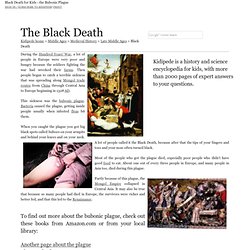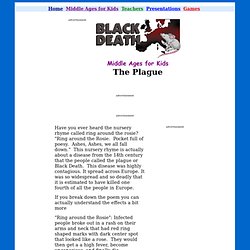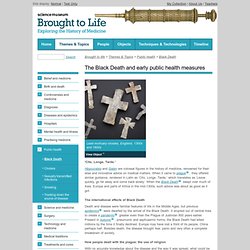

The Impact of the Plague. What effect did the Black Death have on the medieval society. CBBC - Horrible Histories - Whiffy Plague Cure. Terry Deary's Five Horrid Things- The Plague. Black Death ("Hollaback Girl" by Gwen Stefani) The Black Death (Bubonic Plague) - Middle Ages for Kids! During the Hundred Years' War, a lot of people in Europe were very poor and hungry because the soldiers fighting the war had wrecked their farms.

Then people began to catch a terrible sickness that was spreading along Mongol trade routes from China through Central Asia to Europe beginning in 1328 AD. This sickness was the bubonic plague. Bacteria caused the plague, getting inside people usually when infected fleas bit them. When you caught the plague you got big black spots called buboes on your armpits and behind your knees and on your neck. A lot of people called it the Black Death, because after that the tips of your fingers and toes and your nose often turned black. Most of the people who got the plague died, especially poor people who didn't have good food to eat. Partly because of this plague, the Mongol Empire collapsed in Central Asia. To find out more about the bubonic plague, check out these books from Amazon.com or from your local library: Welcome to Kidipede! Or. The Black Death - *Causes and Cures*
Black Death Video — History.com. The Plague! Have you ever heard the nursery rhyme called ring around the rosie?

"Ring around the Rosie. Pocket full of poesy. Ashes, Ashes, we all fall down. " This nursery rhyme is actually about a disease from the 14th century that the people called the plague or Black Death. This disease was highly contagious. If you break down the poem you can actually understand the effects a bit more "Ring around the Rosie": Infected people broke out in a rash on their arms and neck that had red ring shaped marks with dark center spot that looked like a rose. "Pocket full of posey": People carried flowers, often posies, to cover the smell of the dead and dying. "Ashes, Ashes": People would burn the houses of people with the disease in order to try and stop it. "We all fall down": The plague filled villages and cities alike with dead and dying victims. Black Death — History.com Articles, Video, Pictures and Facts. Today, scientists understand that the Black Death, now known as the plague, is spread by a bacillus called Yersina pestis.

(The French biologist Alexandre Yersin discovered this germ at the end of the 19th century.) They know that the bacillus travels from person to person pneumonically, or through the air, as well as through the bite of infected fleas and rats. Both of these pests could be found almost everywhere in medieval Europe, but they were particularly at home aboard ships of all kinds–which is how the deadly plague made its way through one European port city after another. Not long after it struck Messina, the Black Death spread to the port of Marseilles in France and the port of Tunis in North Africa. Then it reached Rome and Florence, two cities at the center of an elaborate web of trade routes. Today, this grim sequence of events is terrifying but comprehensible. Meanwhile, in a panic, healthy people did all they could to avoid the sick.
The Black Death and early public health measures. 'Cito, Longe, Tarde.' Hippocrates and Galen are colossal figures in the history of medicine, renowned for their wise and innovative advice on medical matters.

When it came to plague, they offered similar guidance, rendered in Latin as ‘Cito, Longe, Tarde,’ which translates as ‘Leave quickly, go far away and come back slowly.’ The Black Death. KS3 the black death - the effects of bubonic plague. KS3 Bitesize History - The Black Death : Video. KS3 Bitesize History - The Black Death : Revision. 'Black Death pit' unearthed by Crossrail project. By Jason Palmer Science and technology reporter, BBC News Excavations for London's Crossrail project have unearthed bodies believed to date from the time of the Black Death.

A burial ground was known to be in an area outside the City of London, but its exact location remained a mystery. Thirteen bodies have been found so far in the 5.5m-wide shaft at the edge of Charterhouse Square, alongside pottery dated to the mid-14th Century. History - British History in depth: Black Death. The Black Death, 1348.
The Middle Ages for Kids - the Plague, the Black Death. History - British History in depth: Black Death.